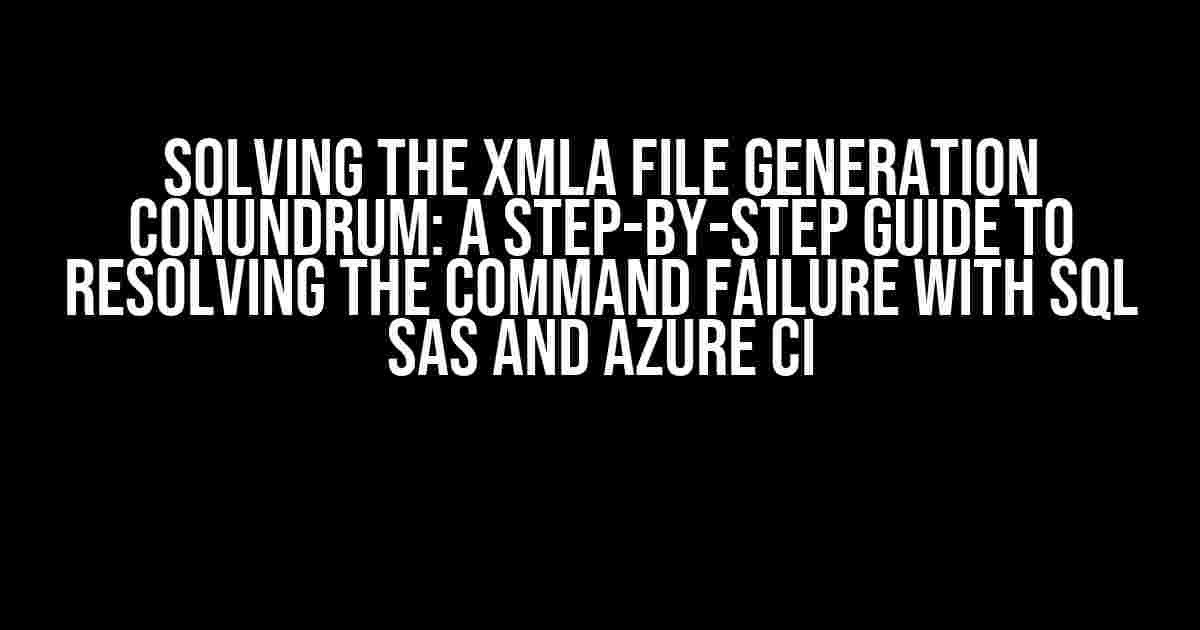Are you tired of encountering the frustrating error “The command is failing while generating XMLA file from ASDatabase” when trying to integrate SQL SAS with Azure CI? Well, worry no more! This comprehensive guide will walk you through the exact steps to resolve this issue and get your XMLA file generation up and running smoothly.
Understanding the Problem
Before we dive into the solution, it’s essential to grasp the root cause of the problem. When you try to generate an XMLA file from AS Database using SQL SAS and Azure CI, the command fails, leaving you with an error message that’s as cryptic as it is infuriating. But fear not, dear reader, for we’re about to break down the solution into manageable, bite-sized chunks.
Prerequisites
To follow along, ensure you have the following components installed and configured correctly:
- SQL SAS (Versions 9.4 or later)
- Azure CI (with Azure DevOps or Azure Pipelines)
- AS Database (with SAS AS Library)
Step 1: Verify AS Database Connections
The first step in resolving the command failure is to verify that your AS Database connections are properly configured.
proc asauth username=<your_username> password=<your_password>;
libname ASLIB SASASAccess "AS Database name";
In the code snippet above, replace <your_username> and <your_password> with your actual AS Database credentials. The proc asauth statement authenticates your connection, while the libname statement assigns the ASLIB libref to your AS Database.
Step 2: Configure SAS XMLA File Generation
To generate the XMLA file, you’ll need to modify the SAS code to include the necessary XMLA file generation settings.
proc asxmla data=ASLIB.your_data
out="C:\Path\To\Output\your_file.xmla"
xmla_version=2.0
replace=yes;
In this example, replace ASLIB.your_data with the actual libref and dataset name from your AS Database. The out parameter specifies the output file path and name, while the xmla_version and replace parameters configure the XMLA file generation settings.
Step 3: Integrate with Azure CI
Now that you’ve configured your AS Database connections and SAS XMLA file generation settings, it’s time to integrate with Azure CI.
Create a new Azure CI pipeline and add a SAS Script task to your pipeline. In this task, specify the path to your SAS program file (containing the code from Step 2) and configure the necessary environment variables.
| Variable | Value |
|---|---|
| SAS_HOME | C:\Path\To\SAS\Home |
| SAS_CONFIG | C:\Path\To\SAS\Config |
In the table above, replace the Value columns with the actual paths to your SAS home directory and configuration files.
Step 4: Resolve Common Issues
By following the steps above, you should be able to generate your XMLA file successfully. However, you may still encounter some common issues that can cause the command to fail.
Issue 1: Authentication Errors
If you encounter authentication errors, ensure that your AS Database credentials are correct and that you’ve specified the correct username and password in your SAS code.
Issue 2: XMLA File Corruption
If the generated XMLA file is corrupted or incomplete, try specifying a different output file path or name. Additionally, verify that the xmla_version parameter is set to a compatible version (e.g., 2.0).
Issue 3: Azure CI Pipeline Errors
If the Azure CI pipeline fails, check the pipeline logs for errors and ensure that the SAS Script task is configured correctly. Verify that the SAS program file is in the correct location and that the environment variables are set correctly.
Conclusion
By following the steps outlined in this guide, you should be able to resolve the command failure issue when generating XMLA files from AS Database using SQL SAS and Azure CI. Remember to verify your AS Database connections, configure your SAS XMLA file generation settings, integrate with Azure CI, and resolve common issues that may arise. With patience and persistence, you’ll be generating XMLA files like a pro in no time!
Happy coding, and don’t hesitate to reach out if you have any further questions or concerns!
Here are 5 FAQs about “SQL SAS| Azure CI | The command is failing while generating xmla file from asdatabase” in HTML format with a creative voice and tone:
Frequently Asked Questions
Get the answers to your burning questions about SQL SAS, Azure CI, and generating XMLA files from ASDatabase!
Why is my Azure CI pipeline failing when generating an XMLA file from ASDatabase?
This could be due to a variety of reasons, including incorrect connection settings, inadequate permissions, or a misconfigured pipeline. Double-check your credentials, ensure you have the necessary permissions, and review your pipeline configuration to identify the issue.
What are the required permissions to generate an XMLA file from ASDatabase using Azure CI?
You need to have the ‘Reader’ role or higher on the ASDatabase and the Azure Storage Account where the XMLA file will be stored. Additionally, ensure that the Azure CI service principal has the necessary permissions to access the ASDatabase and Storage Account.
How do I troubleshoot the XMLA file generation failure in Azure CI pipeline?
Check the Azure CI pipeline logs for errors, review the ASDatabase connection settings, and verify that the XMLA file generation command is correct. You can also try running the command locally to isolate the issue.
Can I use SQL SAS to generate an XMLA file from ASDatabase in Azure CI?
Yes, you can use SQL SAS to generate an XMLA file from ASDatabase in Azure CI. You need to install the required SQL SAS packages and configure the connection settings correctly. Then, you can use the SQL SAS command to generate the XMLA file.
What are the benefits of generating an XMLA file from ASDatabase using Azure CI?
Generating an XMLA file from ASDatabase using Azure CI provides a convenient way to automate the process, reduces manual errors, and enables continuous integration and deployment. It also allows for easy version control and tracking of changes to your ASDatabase.
